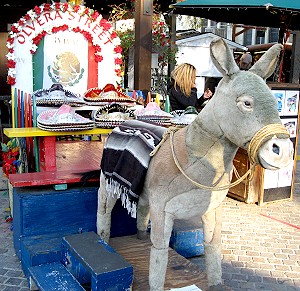
“I love LA” certainly has a better ring to it than “I love El Pueblo de Nuestra Señora la Reina de los Ángeles de la Porciúncula”.
Maybe that’s why the name has been shortened over the years to the point that now it’s just two letters.
This gives Los Angeles the distinction of having both the longest and shortest name for a city in the US and fourth longest in the world.
Prior to being dubbed that mammoth moniker by Don Fernando Rivera y Moncada (his own name a mouthful) and his band of forty-four Spanish settlers back in 1781, the area was inhabited by the Tongva.
The Tongva territory covered all of what we now think of as Southern California and the Channel Islands including Catalina.
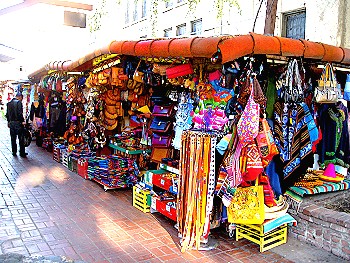
While journeying through The Golden State, we reckoned we ought to see where The City of Angels got its start and that meant a trip into the heart of downtown.
Nestled among the skyscrapers, train stations, bridges and parking lots we found Olvera Street, the “Birthplace of Los Angeles.”
A tiny block of mixed up Spanish-Mexican-Anglo heritage right in the middle of modern America.
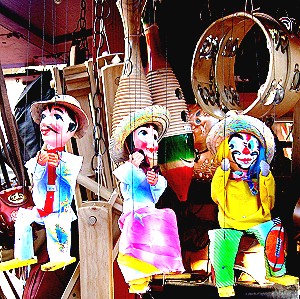
This spot has been the center of LA since the 1820s when the plaza was built on the edge of what was then known as Wine Street. The road was officially renamed Olvera Street in 1877 in honor of Augustín Olvera, a Judge for Los Angeles County.
Nowadays we find a lively tourist area and historical district. Apparently the place rocks during Cinco de Mayo and El Dia de los Muertos, a weeklong celebration of joyful remembrance of lost loved ones.

Our Olvera Street explorations began at Sepúlveda House. Eloisa Martinez de Sepúlveda arrived here in Alta California with her family at the age of eleven.
They had come from the State of Sonora, Mexico, which at that time was a move from one state to another within the country.
Five years later, her family found themselves living under the rule of the United States. Luckily Eloisa’s family were landholders and didn’t suffer the fate of many early inhabitants of the new American Southwest after the Mexican-American War.
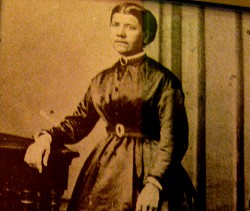
Eloisa was one tough cookie. In 1887, widowed and left without the property given as her marriage dowry, she built a commercial building known as the Sepúlveda Block on land that her also-widowed mother owned, quite a feat for a woman of her day.
The two story Victorian-style building cost Eliosa $8,000 and featured businesses, a boarding facility and her private residence.
Beautifully restored, Sepúlveda House remains today as the Plaza District’s Visitors’ Center and mini museum providing a taste
of life in late nineteenth century Los Angeles.

Armed with information from The Center, we took to the street. The street is flanked by twenty-seven historic buildings dating back to the 1800s, blending Mexican and the newly adopted Anglo architectures.
The original adobe structures from the late 1700s no longer remain. Most buildings are refurbished as restaurants or the ever present tourist area crap shops but we nevertheless got a feel for how LA rolled before Hollywood came to town.
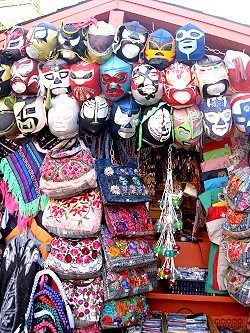
Down the center of the narrow street small carts have set up shop to ply their Mexican wrestling masks, paper flowers, cup and ball toys, sarapes, cheap guitars, puppets and even an Elvis on velvet or two.
Browsing the souvenirs amidst the aromas of the many authentic cafes was killing us, so before we could make the last few exhausting steps to the plaza, a sustenance stop was necessary.
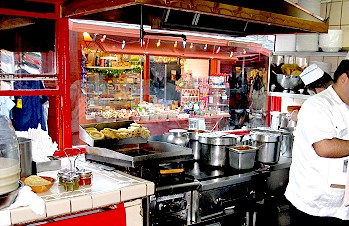
There are plenty of culinary choices on Olvera Street– from table cloths adorned with fine china to walking-around-with wrapped tacos.
We chose an in-between — a sit down and eat from a basket establishment, La Noche Buena, with its colorful atmosphere and tables in full view of the tortilla flinging in the kitchen.
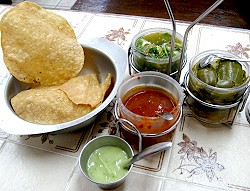
Salsas are generally a good yardstick when sizing up a Mexican restaurant and La Noche Buena did not disappoint.
Four varieties — muy mild mannered to aye carumba! — served with whole fried corn tortillas. Everything else was gravy after that.
After a few tacos al carbon and some killer taquitos, we had regained the strength to manage the last fifty yards or so to the plaza.
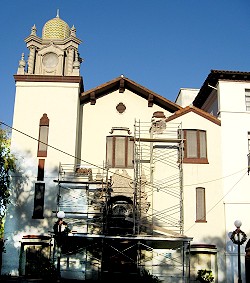
The circular plaza in front of the old church is ringed with historical markers depicting the founding of the LA and its counterpart
settlements up and down the west coast.
Turns out the Spanish had a well governed system of missions and presideos all across
the southwest.
Veronica, a native California girl, was well versed in the mission chronicles, but David was not taught about the Spanish and Mexican side of things while growing up on the prairie in the 1960s.
We’re never too old to learn something new.
David & Veronica, GypsyNester.com



I found your site from Google and I have to state it
was an excellent locate. Many thanks!
i really enjoy reading your blogs. It is like taking a trip without having to leave home. Keep up the great writing.
Thanks so much! We’ll do our best to keep you hooked. 😉
LOVE these photos and historic L.A.!
>♫♥☼ Mexican Food..Yumminess….
>Love Olvera Street! Thanks for the memory flashback. 🙂